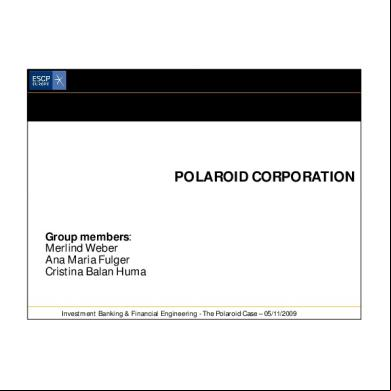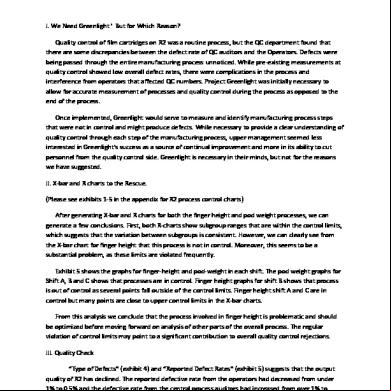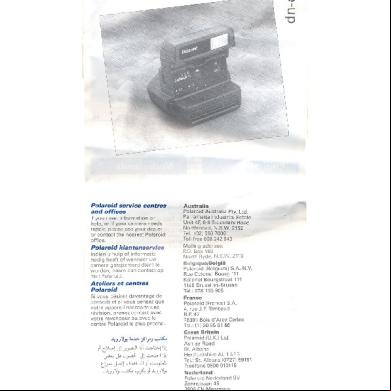Presentation Polaroid 2636g
This document was ed by and they confirmed that they have the permission to share it. If you are author or own the copyright of this book, please report to us by using this report form. Report 2z6p3t
Overview 5o1f4z
& View Presentation Polaroid as PDF for free.
More details 6z3438
- Words: 1,213
- Pages: 7
11/5/2009
POLAROID CORPORATION
Group : Merlind Weber Ana Maria Fulger Cristina Balan Huma Investment Banking & Financial Engineering - The Polaroid Case – 05/11/2009
1
11/5/2009
1. What is Polaroid current capital structure at book/market values? Long term debt
526.7
Common shareholder's equity
717.7
Short term liabilities
1017.4
Total liabilities
1544.1
Book value of the company
2261.8
Current capital structure at book value
717.7
Equity Debt
1544.1
Debt composition 719
817.2
526.7
Current liabilities Long term debt Other liabilities
Capital structure at market values 42%
Equity value 58%
Debt Value
- Assuming that the book value of debt is equal to the market value of the debt (there are no costs of bankruptcy) we can infer the following capital structure: - The market value of the equity is about three times bigger than the book value of the equity. These values would indicate that at the moment the stock is overvalued by investors Investment Banking & Financial Engineering - The Polaroid Case – 05/11/2009
2
11/5/2009
Percentage from total capital
2. How has the capital structure evolved? Evolution of the long term debt to capital 1986 - 1995
-
-
60.00% 50.00% 40.00% 30.00% 20.00% 10.00% 0.00%
1986 1987 1988 1989 1990 1991 1992 1993 1994 1995
Book Value long term debt/Capital Market Value Long term debt/Capital Founded in 1937 by Edwin Land, Polaroid has been for a long time after its foundation an all equity firm. A major change in the firm’s capital structure occurred from 1988 to 1989 when the debt to capital ratio increased up to 56%, as a response to the unsolicited tender offer from Shamrock Holdings, when the management decided the use of an employee stock ownership plan (ESOP). There have not been any major changes in the debt level after 1988-1989. An important issue to date (1995) is whether the actual level of debt is sustainable and adequate for Polaroid’s business model and the industry they operate in. Investment Banking & Financial Engineering - The Polaroid Case – 05/11/2009
3
11/5/2009
5.How much debt could Polaroid take at each rating level? ü
ü
Having an equity value of 717.7, we can compute the level of long term debt to capital for each credit rating. For example, if the equity value is 717.7 and the long term debt to capital ratio is 42.7% we can compute the maximum long term debt available as for the BBB rating, which is 534.83 mil. USD. Following the same algorithm, we get the following long term debt for each rating level: Another ratio taken into when asg credit ratings is total debt over capital. The total debt component includes the long term debt plus current maturities, commercial paper borrowings and other short term borrowings. The denominator includes long term debt plus current maturities, commercial paper, and other short term borrowings and shareholder’s equity (including preferred stock) plus minority interest. Rating
AAA
AA
A
BBB
BB
B
Total debt/Capital including short term debt
26%
33.60%
39.70%
47.80%
59.40%
69.50%
585.81
759.96
897.93
1081.14
1343.51
1571.95
Free operating cash flow/total debt
60%
26.80%
20.90%
7.20%
1.40%
-0.90%
Total Debt
145
324.62 416.268
1208.33
6214.28
9667.87
0.316
0.427
0.556
0.655
110.097 191.9324 331.569
534.8305
898.7414
1362.59
Total debt
Long term debt/capital Long term debt •
0.133
0.211
The findings in this exhibit are consistent with the actual BBB rating Polaroid has and its long term debt value of 526.7
Investment Banking & Financial Engineering - The Polaroid Case – 05/11/2009
4
11/5/2009
5.How much debt could Polaroid take at each rating level? ü
Using the free operating cash flow to total debt ratio, one can infer the total debt Polaroid can take for each rating level. This ratio can be computed by comparing the free cash flow to the long term debt and short term of the company.
ü
FCF = EBIT*(1-tc) +DepreciationCAPEX -/+?·NWK
ü
In computing the free cash flow of Polaroid in 2005 the 247 mil. USD in restructuring expenses were excluded, as one can reasonably expect that this expenditure is not likely to occur in the future.
Revenues= Net Sales
2236.9
Operating expenses
2147.7
Depreciation
132.7
Variation in net working capital
148.3
CAPEX
167.9
Tax rate
40%
FCF
87
Working capital 2005
738.5
Working capital 2004
886.8
Change in working capital -148.3 Capital expenditures are presented in the Exhibit 1 as additions to property, plant and equipment.
Investment Banking & Financial Engineering - The Polaroid Case – 05/11/2009
5
11/5/2009
5. What EBIT coverage ratios would result from the borrowings implied in each rating category? EBIT coverage ratio relates the company’s earnings before interest and taxes to its interest expense. The lower the interest coverage ratio, the higher will be the company's debt burden and the greater the possibility of bankruptcy or default. That is why this ratio should increase when moving from junk B rated companies to AAA rated companies. Having an EBIT of 89.2 in 1995, Polaroid’s EBIT coverage ratio is 7.1. Using exhibit 11, one may compute the EBIT coverage ratios for each rating category. The EBIT coverage ratio for Polaroid in each credit rating category is very sensitive to the future earnings before interest and taxes the enterprise will generate and to the evolution of the cost of debt for each category. Taking into the interest coverage ratio is important because it can give a clear picture of the short-term financial health of the business. As it can be seen above, Polaroid will not only need to lower its debt but also will need to generate a higher EBIT in order to qualify for a better rating. Rating
AAA
AA
A
BBB
BB
B
EBIT coverage ratio – median values for industry
13.5
9.67
5.76
3.94
2.14
1.17
Total debt/Capital including short term debt
26%
33.60%
39.70%
47.80%
59.40%
69.50%
585.8062
759.9648
897.9346
1081.14
1343.509
1571.951
6.70%
6.90%
7%
7.40%
9%
10.60%
89.2
89.2
89.2
89.2
89.2
89.2
Interest expense
39.24902
52.43757
62.85542
80.00439
120.9158
166.6268
Polaroid's EBIT coverage ratio
2.272668
1.70107
1.41913
1.114939
0.737703
0.535328
6.222831
4.65773
3.885743
3.052832
2.019918
1.465791
Total debt Cost of debt EBIT
Polaroid's EBIT coverage ratio if using the EBIT forecast from exhibit 6(average)
Investment Banking & Financial Engineering - The Polaroid Case – 05/11/2009
6
11/5/2009
4. Is the current capital structure the result of explicit capital structure management or past benefits and distribution policy?
ü The management’s discussion in the fillings of the company to SEC show a continuous concern on the capital structure of the company. ü Unfortunately, there has not been a clear-cut plan or a long term strategy in respect to the debt and equity proportions. ü The increase in debt occurred as a result of a takeover threat and then fluctuated around the level of 40%. ü The current capital structure was determined mainly by: – The winning of the patent infringement with Kodak(inflow of about 900 million USD); – The unsolicited tender offer from Shamrock Holdings(the response - leveraged recapitalization)
In conclusion, the capital structure in 1995 appears to be more a consequence of past benefits and the distribution policy than the result of an explicit capital structure management, though there might be a target debt level(for credit rating reasons mainly). Investment Banking & Financial Engineering - The Polaroid Case – 05/11/2009
7
POLAROID CORPORATION
Group : Merlind Weber Ana Maria Fulger Cristina Balan Huma Investment Banking & Financial Engineering - The Polaroid Case – 05/11/2009
1
11/5/2009
1. What is Polaroid current capital structure at book/market values? Long term debt
526.7
Common shareholder's equity
717.7
Short term liabilities
1017.4
Total liabilities
1544.1
Book value of the company
2261.8
Current capital structure at book value
717.7
Equity Debt
1544.1
Debt composition 719
817.2
526.7
Current liabilities Long term debt Other liabilities
Capital structure at market values 42%
Equity value 58%
Debt Value
- Assuming that the book value of debt is equal to the market value of the debt (there are no costs of bankruptcy) we can infer the following capital structure: - The market value of the equity is about three times bigger than the book value of the equity. These values would indicate that at the moment the stock is overvalued by investors Investment Banking & Financial Engineering - The Polaroid Case – 05/11/2009
2
11/5/2009
Percentage from total capital
2. How has the capital structure evolved? Evolution of the long term debt to capital 1986 - 1995
-
-
60.00% 50.00% 40.00% 30.00% 20.00% 10.00% 0.00%
1986 1987 1988 1989 1990 1991 1992 1993 1994 1995
Book Value long term debt/Capital Market Value Long term debt/Capital Founded in 1937 by Edwin Land, Polaroid has been for a long time after its foundation an all equity firm. A major change in the firm’s capital structure occurred from 1988 to 1989 when the debt to capital ratio increased up to 56%, as a response to the unsolicited tender offer from Shamrock Holdings, when the management decided the use of an employee stock ownership plan (ESOP). There have not been any major changes in the debt level after 1988-1989. An important issue to date (1995) is whether the actual level of debt is sustainable and adequate for Polaroid’s business model and the industry they operate in. Investment Banking & Financial Engineering - The Polaroid Case – 05/11/2009
3
11/5/2009
5.How much debt could Polaroid take at each rating level? ü
ü
Having an equity value of 717.7, we can compute the level of long term debt to capital for each credit rating. For example, if the equity value is 717.7 and the long term debt to capital ratio is 42.7% we can compute the maximum long term debt available as for the BBB rating, which is 534.83 mil. USD. Following the same algorithm, we get the following long term debt for each rating level: Another ratio taken into when asg credit ratings is total debt over capital. The total debt component includes the long term debt plus current maturities, commercial paper borrowings and other short term borrowings. The denominator includes long term debt plus current maturities, commercial paper, and other short term borrowings and shareholder’s equity (including preferred stock) plus minority interest. Rating
AAA
AA
A
BBB
BB
B
Total debt/Capital including short term debt
26%
33.60%
39.70%
47.80%
59.40%
69.50%
585.81
759.96
897.93
1081.14
1343.51
1571.95
Free operating cash flow/total debt
60%
26.80%
20.90%
7.20%
1.40%
-0.90%
Total Debt
145
324.62 416.268
1208.33
6214.28
9667.87
0.316
0.427
0.556
0.655
110.097 191.9324 331.569
534.8305
898.7414
1362.59
Total debt
Long term debt/capital Long term debt •
0.133
0.211
The findings in this exhibit are consistent with the actual BBB rating Polaroid has and its long term debt value of 526.7
Investment Banking & Financial Engineering - The Polaroid Case – 05/11/2009
4
11/5/2009
5.How much debt could Polaroid take at each rating level? ü
Using the free operating cash flow to total debt ratio, one can infer the total debt Polaroid can take for each rating level. This ratio can be computed by comparing the free cash flow to the long term debt and short term of the company.
ü
FCF = EBIT*(1-tc) +DepreciationCAPEX -/+?·NWK
ü
In computing the free cash flow of Polaroid in 2005 the 247 mil. USD in restructuring expenses were excluded, as one can reasonably expect that this expenditure is not likely to occur in the future.
Revenues= Net Sales
2236.9
Operating expenses
2147.7
Depreciation
132.7
Variation in net working capital
148.3
CAPEX
167.9
Tax rate
40%
FCF
87
Working capital 2005
738.5
Working capital 2004
886.8
Change in working capital -148.3 Capital expenditures are presented in the Exhibit 1 as additions to property, plant and equipment.
Investment Banking & Financial Engineering - The Polaroid Case – 05/11/2009
5
11/5/2009
5. What EBIT coverage ratios would result from the borrowings implied in each rating category? EBIT coverage ratio relates the company’s earnings before interest and taxes to its interest expense. The lower the interest coverage ratio, the higher will be the company's debt burden and the greater the possibility of bankruptcy or default. That is why this ratio should increase when moving from junk B rated companies to AAA rated companies. Having an EBIT of 89.2 in 1995, Polaroid’s EBIT coverage ratio is 7.1. Using exhibit 11, one may compute the EBIT coverage ratios for each rating category. The EBIT coverage ratio for Polaroid in each credit rating category is very sensitive to the future earnings before interest and taxes the enterprise will generate and to the evolution of the cost of debt for each category. Taking into the interest coverage ratio is important because it can give a clear picture of the short-term financial health of the business. As it can be seen above, Polaroid will not only need to lower its debt but also will need to generate a higher EBIT in order to qualify for a better rating. Rating
AAA
AA
A
BBB
BB
B
EBIT coverage ratio – median values for industry
13.5
9.67
5.76
3.94
2.14
1.17
Total debt/Capital including short term debt
26%
33.60%
39.70%
47.80%
59.40%
69.50%
585.8062
759.9648
897.9346
1081.14
1343.509
1571.951
6.70%
6.90%
7%
7.40%
9%
10.60%
89.2
89.2
89.2
89.2
89.2
89.2
Interest expense
39.24902
52.43757
62.85542
80.00439
120.9158
166.6268
Polaroid's EBIT coverage ratio
2.272668
1.70107
1.41913
1.114939
0.737703
0.535328
6.222831
4.65773
3.885743
3.052832
2.019918
1.465791
Total debt Cost of debt EBIT
Polaroid's EBIT coverage ratio if using the EBIT forecast from exhibit 6(average)
Investment Banking & Financial Engineering - The Polaroid Case – 05/11/2009
6
11/5/2009
4. Is the current capital structure the result of explicit capital structure management or past benefits and distribution policy?
ü The management’s discussion in the fillings of the company to SEC show a continuous concern on the capital structure of the company. ü Unfortunately, there has not been a clear-cut plan or a long term strategy in respect to the debt and equity proportions. ü The increase in debt occurred as a result of a takeover threat and then fluctuated around the level of 40%. ü The current capital structure was determined mainly by: – The winning of the patent infringement with Kodak(inflow of about 900 million USD); – The unsolicited tender offer from Shamrock Holdings(the response - leveraged recapitalization)
In conclusion, the capital structure in 1995 appears to be more a consequence of past benefits and the distribution policy than the result of an explicit capital structure management, though there might be a target debt level(for credit rating reasons mainly). Investment Banking & Financial Engineering - The Polaroid Case – 05/11/2009
7





